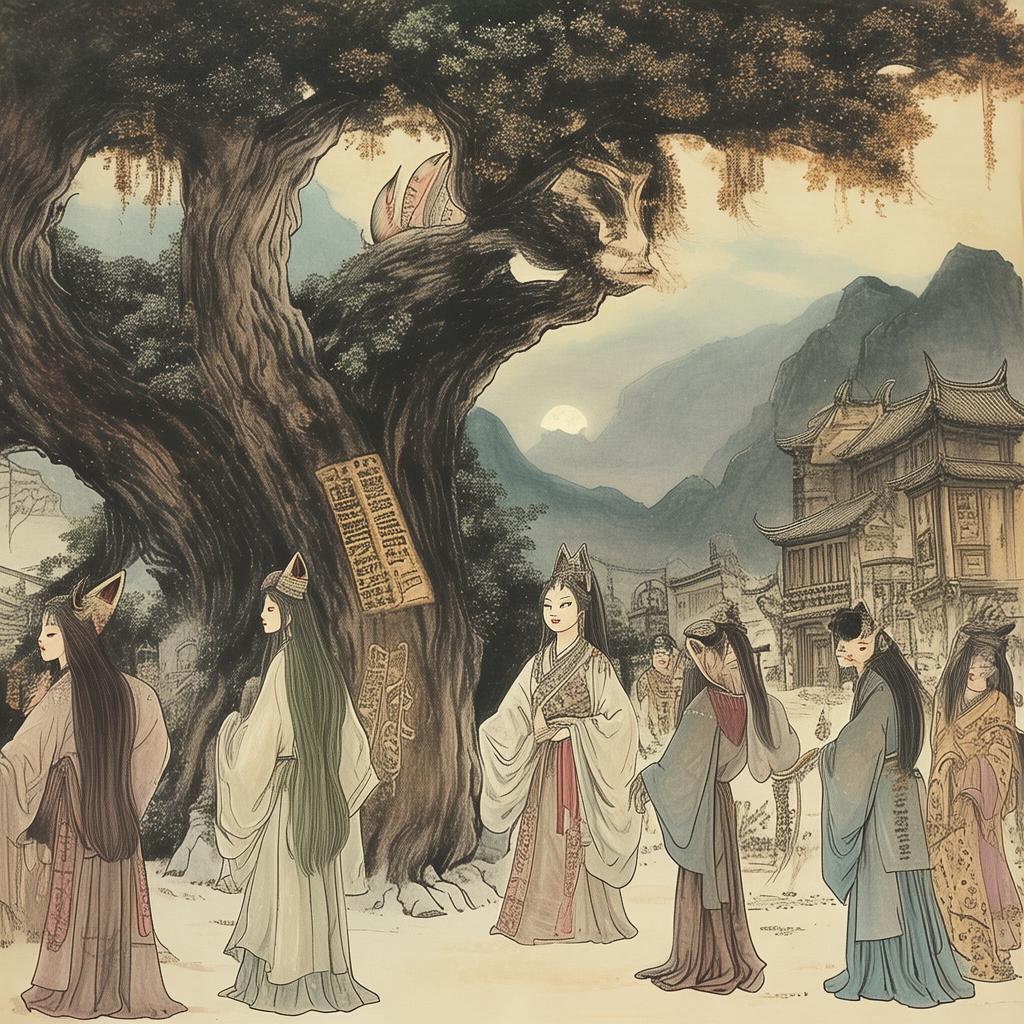The Calligrapher's Curse
In the quaint village of Wutai, nestled between rolling hills and whispering rivers, there lived a young calligrapher named Ming. His hands, delicate and skilled, had a knack for turning ink into poetry on paper. Ming's father, a revered calligrapher, had passed down his art, but it was Ming who carried the torch, dreaming of one day creating a masterpiece that would echo through the ages.
One crisp autumn morning, as the sun rose like a golden coin from behind the mountains, Ming stumbled upon an ancient scroll hidden beneath a pile of old books in the attic. The scroll was crumpled and dusty, its edges worn thin by time. Intrigued, he unrolled it and gasped at the intricate patterns and ancient script that danced across the parchment.

The characters were unlike any he had seen before, a blend of the traditional and the mystical. As he traced his fingers over the lines, he felt a strange pull, as if the scroll was calling to him. The characters began to glow faintly, and a voice, deep and resonant, echoed in Ming's mind.
"I am the Script of the Ancestors' Imagination," the voice said. "I hold the secrets of the past and the future. You have been chosen to unlock my power."
Ming's heart raced. He had heard tales of ancient calligraphers who could communicate with the spirits, but he had always dismissed them as mere legends. Now, he found himself standing on the precipice of the unknown.
The scroll spoke of a mystical realm where the ancestors' imagination was a force of nature, a world of dreams and desires, fears and aspirations. It was a realm that could only be accessed through the art of calligraphy. The ancestors had left behind a legacy of scripts, each holding the key to a different aspect of this world.
Ming knew he had to learn the ancient art of calligraphy to understand the scroll's true power. He began his journey, seeking out the wisdom of the elders and poring over ancient texts. His hands, once nimble, grew calloused as he practiced for hours on end, copying the intricate patterns until his eyes blurred.
One night, as he worked late into the night, Ming felt a presence behind him. He turned to see an old man, his eyes twinkling with ancient knowledge.
"You are ready, Ming," the old man said, his voice a mixture of awe and excitement. "The ancestors have chosen you to be their voice in this world."
With the old man's guidance, Ming began to weave the scripts into his own work, creating calligraphy that seemed to come alive. The characters no longer danced on the paper; they moved, whispering secrets and tales from the ancestors' imagination.
Word of Ming's newfound ability spread like wildfire through the village. People sought him out, hoping to have their names or wishes inscribed in the ancient script. Ming's art became a bridge between the living and the ancestors, a way to honor the past and to connect with the future.
But as Ming's fame grew, so did the curiosity of those who saw him as a threat. The scroll had not only revealed the power of the ancestors' imagination but also the potential for misuse. A wealthy merchant, covetous of Ming's talent, offered him a fortune to destroy the scroll and keep the secrets to himself.
Ming knew that he could not betray the ancestors. He had been chosen to protect their legacy, not to sell it. He refused the merchant's offer, and in doing so, he invited a curse upon himself. The scroll, sensing Ming's loyalty, began to fade, its glow dimming, its voice growing faint.
The merchant, in a fit of rage, cursed Ming's art, declaring that it would never be truly understood unless he could create a script that could bring back the ancestors' imagination. Ming, however, knew that the true power lay not in the creation of a new script, but in the understanding and respect for the one he already had.
In a final act of defiance, Ming wrote the scroll's last words on the parchment, a testament to his love for the art and the ancestors. The scroll, now complete, shone with a brilliant light, enveloping Ming in a warm glow.
When the light faded, Ming found himself standing in the mystical realm of the ancestors' imagination. There, he met the ancestors themselves, who thanked him for his loyalty and presented him with a new script, one that would ensure the survival of their legacy.
Ming returned to the village, the scroll now a symbol of his bond with the ancestors. His art thrived, and he continued to create, knowing that his work was not just a reflection of his own imagination but a continuation of the ancestors' dreams and desires.
The Calligrapher's Curse, a tale of loyalty, imagination, and the enduring power of art, became a legend in Wutai, a story that would be told for generations to come.
✨ Original Statement ✨
All articles published on this website (including but not limited to text, images, videos, and other content) are original or authorized for reposting and are protected by relevant laws. Without the explicit written permission of this website, no individual or organization may copy, modify, repost, or use the content for commercial purposes.
If you need to quote or cooperate, please contact this site for authorization. We reserve the right to pursue legal responsibility for any unauthorized use.
Hereby declared.









